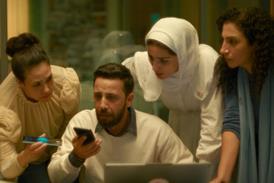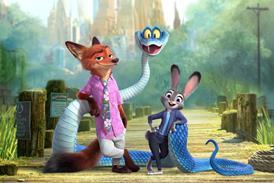
Japanese fantasy feature Dragon Heart: Adventures Beyond This World combines traditional Japanese hand-painted anime techniques with state-of-the-art digital effects and has been entered for the best animated feature category at the 2026 US Academy Awards.
Directed by Isamu Imakake, it details the physical and spiritual journey of two young cousins who meet one summer in Tokushima in rural Japan. They are swept into a river and find themselves on a journey through the spirit world. As they sink to the bottom of the river, a dragon appears, rescues them, and takes them to a mysterious old man who tells they are already dead, but that he can send them back to life if they explore the spirit world and find their mission in life.
The pair then venture on an epic journey, first through hell, followed by heaven, with the cousins needing to find a way through to reach the end and discover if they have achieved a return to life.
Dragon Heart: Adventures Beyond This World has been brought to the screen by Ryuho Okawa, the founder and CEO of the self-described philosophical movement Happy Science. Okawa has created the story and five original songs for the film.
Director Imakake has a resume that includes work as a Japanese animator, animation director, television director and producer. He has also worked as an illustrator for manga features such as Geobreeders and was VFX supervisor and director on several animated features, including the big screen version of StreetFighter II, based on the computer game

The animation production of Dragon Heart started in 2022 after three years of preproduction “The whole project began when we received the original story idea from the executive producer [Okawa] in 2019,” Imakake explains. “Based on other resources related to the film’s original story, such as books [on Japanese myths, folklore], we came up with the synopsis and then we developed a screenplay scenario.”
“It took a year alone, going through many revisions, to develop the screenplay based on the original story,” Imakake said. “After executive producer [Okawa] approved the screenplay, I developed the storyboards.
Those storyboards included characters and the depictions of the many locations in the film, from Tokyo to Tokushima and to India, Nepal and China, alongside renditions of the imagined spirit world.
For Imakake, one of the most interesting aspects of directing Dragon Heart was finding innovative ways to incorporate the five songs into the film while maintaining narrative rhythm and forward momentum for the two main characters.
“We storyboarded the songs to make sure they flowed with the story,” the filmmaker explains. “The songs are all different parts of the two’s journey. That was a part of the flow of the story.”
Because it is Japanese animation, Imakake wanted to use mainly hand-drawn animation, handled by the animators at Happy Science’s HS Pictures Studio. Some work was outsourced to specialist Japanese anime studios.
“We also used 3D motion capture and computer graphics, but we wanted to value the movements and champion hand-drawn animation and that analogue feel,” Imakake explains. “I believe that animation is created from our thoughts and imagination.”
The dragon, which is seen throughout the film carrying the duo through the spirit world and across borders into China, India and Tibet, was initially created using a three-dimensional computer process. “After we came up with the design, we asked the animators to add hand-drawn animation to it and over it,” says Imakake.
For the template backgrounds of the real world, the animation team used photographs of real places such as Japan’s Anabuki River and the rural villages, with the aim of depicting the beauty of nature from a spiritual perspective.
“We wanted to portray the beauty of the river, to draw the animation of how the river flows, to really illustrate the beauty of the real world,” Imakake explains.
Imakake was determined to avoid portraying hell – one of Dragon Heart’s central conceptual pillars – as the regular seen-on-screen version of fire and brimstone. Instead, the hell of Dragon Heart is based on nightmarish, real-world happenings, whether that be bearing witness to a gangland shooting and being chased down by gang members, a prison-like hospital, where the medical staff are not there to heal but to hurt, or having to escape a train blown up by a suicide bomber.
For Imakake, making the film was a spiritual experience in and of itself. “We all practised meditation. We looked within ourselves throughout the process,” he says. “It helped order the film, as well as my mind.”
























No comments yet